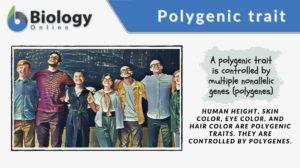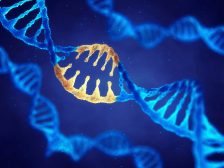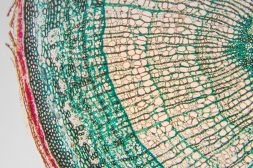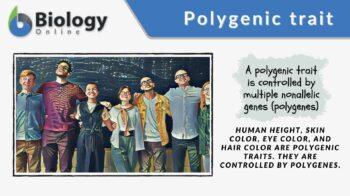
Polygenic trait
n., plural: polygenic traits
[ˌpɒliˈdʒɛnik tɹeɪt/]
Definition: A trait controlled by polygenes
Table of Contents
Polygenic Trait Definition
Polygenic trait refers to a trait that is controlled by multiple non-allelic genes. These genes are called polygenes. They are a group of genes that, when turned on, are expressed as a unit. Each of them produces an effect that adds up to the trait. Nevertheless, the effect of an individual gene is hard to distinguish, especially since a polygenic character involves several genes.

The resulting phenotypic character is often an intermediate of heritable characters whereas the traits at the extremes are not as frequent as the intermediates. Thus, the polygenic trait distribution could be depicted as a continuous variation in a bell shape pattern. Because of the wide range of trait variations, the possible trait outcomes cannot be easily and straightforwardly categorized into groups, e.g. into either white or black, but by a wide spectrum, such as from light to dark.
In humans, height, skin color, hair color, and eye color are examples of polygenic traits. Type-2 diabetes, coronary heart disease, cancer, and arthritis are also deemed polygenic. However, these conditions are not just genetic since polygenes can be influenced by environmental factors.
Etymology
The term polygenic comes from poly, meaning “many” and genic, meaning “of genes”.
Polygenic vs. Mendelian Inheritance
A polygenic trait is a trait that arises from polygenic inheritance. Polygenic inheritance is a non-Mendelian, which means that it does not follow Mendelian laws. Mendelian laws are the laws proposed by the Austrian monk and botanist, Gregor Mendel. His breeding experiments and analysis of garden pea plants from 1856 to 1863 were initially unnoticed. They were recognized only in the early 20th century. His works were found to be correct more than three decades later when the works of Erich von Tschermark, Hugo de Vries, Carl Correns, and William Jasper Spillman verified Mendel’s works by their independent studies. (1)
An example of Mendelian inheritance is monogenic inheritance, a form of inheritance wherein only one pair of alleles or one gene is involved. By using a Punnett square, the phenotypic ratio of a test cross involving a single pair of alleles can be predicted easily as it follows Mendelian laws, particularly, the Law of Unit Characters, Law of Segregation, and Law of Independent Assortment.
However, with further studies, it was later found that some forms of inheritance and the resulting phenotypic ratio did not conform to these laws. One of them is polygenic inheritance. This is because this form of inheritance is controlled not by a single gene (or one pair of alleles) but by multiple genes (called polygenes), which may be located at different loci on different chromosomes. These polygenes tend to be expressed together to produce a particular phenotypic trait. This trait produced by the expression of a number of genes is referred to as a polygenic trait.
In polygenic inheritance, Punnett square would show greater offspring variations from a test cross, and therefore, would not be as straightforward as it is in a monogenic inheritance.
Monogenic Trait vs. Polygenic Trait
As mentioned earlier, a monogenic trait is a trait that results when a single gene or a pair of alleles is expressed. In one of Mendel’s breeding experiments, this would be exemplified by the seed color of the garden pea. A cross between a true-breeding yellow-seeded pea and a true-breeding green-seeded pea resulted in an offspring that produced only yellow seeds. The green seed trait was observed to resurface in the next generation (F generation), reappearing at a ratio of 3:1, meaning for every three offspring producing yellow seeds, there was one that produced green.
Based on these findings, Mendel proposed that the trait that was expressed (yellow) was the dominant whereas the trait that was masked (green) was recessive. A monogenic trait would, therefore, be more upfront, and can be classified into groups, in this case, either yellow or green.
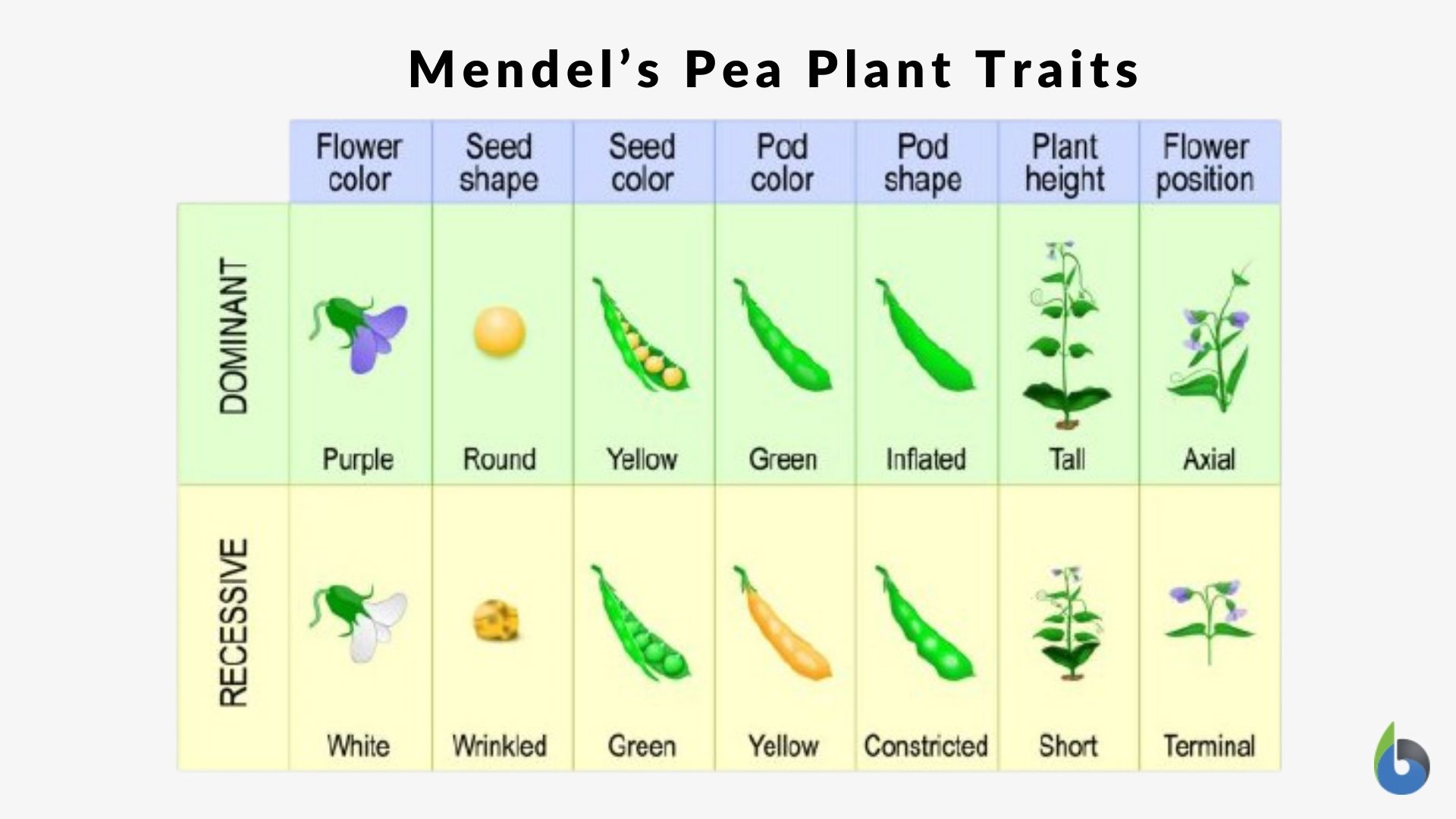
A polygenic trait is a trait that results from the expressions of many genes. These genes apparently produced an additive effect on the phenotype of the offspring. Thinks of it as a painting on an art canvas created by putting together different colors and intensities. Thus, a polygenic character would be a cumulative polygenic action.
In the case of a single dominant allele, its expression is only a unit and not the totality of the trait. Thus, a polygenic trait would be quantitative as opposed to a monogenic trait that is qualitative. Since several genes are responsible for the polygenic trait, the phenotypic ratio of F generation would, therefore, diverge from the 3:1. Despite the multiple genes acting on a trait, their independent effects can be hardly distinguished. Another feature of a polygenic trait is its susceptibility to environmental influence. Apart from polygenes, environmental conditions may have an effect on the polygenic trait.
Bell-shaped Distribution
While monogenic produces discontinuous variation when expressed, polygene produces continuous variation. Polygenic characters are often expressed in the intermediate form. There are only a few dominant and recessive forms. Because of this, frequencies and ratios are not as useful in predicting polygenic variations as they are in monogenic variations. In polygenic inheritance, variations are determined and analyzed by means of variances, co-variances, and averages. The frequency of the phenotypes of polygenic characters tends to follow a normal continuous range of variation (e.g. from lowest to highest, thinnest to thickest, shortest to longest, lightest to darkest, etc.). To put it simply, the range of variation is in a bell-shaped distribution pattern. Thus, polygenes allow a large number of possibilities in terms of phenotypic traits.
Polygenic Inheritance Examples
Many human traits are polygenic. The expression of polygenic traits in humans is exemplified by height, skin color, and eye color. Polygenes give the advantage of producing a wider spectrum of phenotypic and genotypic variations in the population.
Human height is regulated by several genes resulting in a wide range of heights in a population. A genome-wide association study identified 697 genetic variants in 423 genetic loci that were at play in determining the height of an adult human. (2)
Apart from genetic predisposition, non-genetic factors (e.g. nutrition) can also influence the trait. Thus, one can hardly predict the height of the offspring based on the heights of the parents. The offspring could be short despite having a tall parent. Similarly, two short parents may sire a tall child. There could also be cases when the child will have a height intermediate to the parents.
The color of the skin, hair, and eyes are also polygenic traits. These traits depend on how much the body produces and deposits the pigment, melanin. An individual that inherits several alleles related to melanin production and deposition would likely have a dark complexion on skin, hair, and eyes. In another example, a person who inherits alleles for melanin production and deposition in the skin but lacks the alleles for melanin in the eyes will likely have a darker skin color but lighter eye color. Conversely, a person that does not have many alleles for melanin production and deposition will have a lighter complexion.
Polygenic traits should not be confused with codominant traits. Blood type AB in humans, for instance, is not a polygenic trait. Rather, it is a case of codominance. The two alleles for A and B antigens on the red blood cells of blood type AB individuals are dominant and therefore are expressed together.
Polygenic Disease
A polygenic disease is a genetic disorder caused by polygenes. An example of a polygenic condition that may lead to disease is type-2 diabetes. The genes that contribute to this disorder are believed to be mostly polygenes. (3) According to recent findings, there are more than 36 genes and each of these genes contributes to the increased risk of developing type-2 diabetes. (4, 5) The inheritance, for instance, of TCF7L2 allele cab increase the risk of diabetes by 1.5 times. (6)
Apart from type-2 diabetes, other examples of polygenic conditions that are medically important are hypertension, coronary heart disease, cancer, arthritis, and mental illness. These conditions, though, are not entirely genetic. There could also be environmental factors involved that increase the risk of an individual acquiring any of them. Nevertheless, inheriting many of the genes attributable to them increases the risk as they are polygenes that act by cumulative action. (7)
Try to answer the quiz below to check what you have learned so far about polygenic traits.
Further Reading
References
- Nirenberg: History Section: Gregor Mendel. (2019). Retrieved from Nih.gov website: https://history.nih.gov/exhibits/nirenberg/HS1-mendel.htm
- Wood AR, et al. (2014). “Defining the role of common variation in the genomic and biological architecture of adult human height”. Nature Genetics. 46 (11): 1173–1186.
- Rosenbloom, A. L., Joe, J. R., Young, R. S., & Winter, W. E. (1999). Emerging epidemic of type 2 diabetes in youth. Diabetes Care, 22(2), 345–354. https://doi.org/10.2337/diacare.22.2.345
- Melmed, S., Polonsky, K. S., Larsen, P. R., & Kronenberg, H. M., eds. (2011). Williams textbook of endocrinology (12th ed.). Philadelphia: Elsevier/Saunders. pp. 1371–1435.
- Herder C, Roden M (June 2011). “Genetics of type 2 diabetes: pathophysiologic and clinical relevance”. European Journal of Clinical Investigation. 41 (6): 679–92.
- Gardner, D. G., Shoback, D., eds. (2011). “Chapter 17: Pancreatic hormones & diabetes mellitus”. Greenspan’s basic & clinical endocrinology (9th ed.). New York: McGraw-Hill Medical.
- Williamson, R., & Kessling, A. M. (1990). The problem of polygenic disease. Ciba Foundation Symposium, 149, 63–70; discussion 70-80. https://doi.org/10.1002/9780470513903.ch6
© Biology Online. Content provided and moderated by Biology Online Editors

